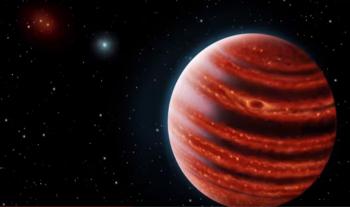In collaboration with the Observatory of Bordeaux and the University of Bern in Switzerland, a researcher of the Astrophysics Departement-Laboratory AIM at CEA-IRFU has demonstrated the existence of significant instabilities in supersonic winds at the surface of giant planets very close to their star, described as "hot Jupiters". Using idealized 3D hydrodynamic simulations at high spatial resolution, the team showed that violent equatorial winds of the hot Jupiters are destabilized by instabilities called Kelvin-Helmholtz, well known in laboratory hydrodynamics. These instabilities cause oscillations of the wind trajectory around the equator and could be responsible for the appearance of shocks in the upper layers of the atmosphere. These phenomena may significantly affect the infrared emission and the atmospheric chemistry of these planets. These results are published in the journal Astronomy & Astrophysics
Strong winds in hot Jupiters
"Hot Jupiters" are planets with a mass similar to that of the planet Jupiter, which are in very tight orbit around their host star. While Jupiter is at an average distance of 780 million kilometers from the Sun, these planets are usually very close to their stars, at distances of only 5 to 10 million kilometers. They are therefore very hot and the temperature of their atmosphere can reach 2000 K (whereas on Jupiter, it is only at 165K or -108°C). They are therefore relatively easy to observe and, for this reason, the study of climatology of these planets is growing significantly in recent years.
Astrophysicists believe that, like Jupiter, these planets are shrouded by a thick gas layer. Because of their proximity to their stars, it is also likely that, by tidal effects, these planets always present the same face to their stars, as is the case of the Moon with respect to Earth. The dayside (toward the star) receives an irradiation nearly 500 times that of the Earth, unlike the night side (opposite the star) that is permanently in darkness. This differential heating of the two hemispheres of the atmosphere is at the origin of the occurrence of an equatorial jet in the form of winds up to several thousands of km/h.
For the first time, researchers were able to use high spatial resolution to perform 3-D numerical simulations of the hydrodynamic instabilities in this region [1].

Result of a 3D simulation of the heated atmosphere of a hot Jupiter. Map in longitude-latitude shows the velocity field around the equator of the planet (the speeds are graduated in increasing intensity from blue to red). A strong wind is visible near the equator (y = 0) showing variations in its orientation. The ondulations in the wind direction that vary over time are related to the development of instabilities. Credits CEA-SAp
The evolution of winds, reproduced during one-day of the planet, shows oscillations of the jet path around the equator, similar in shape to river bends. These oscillations are caused by instabilities called Kelvin-Helmholtz that occur when two layers of adjacent fluids have different speeds. These instabilities, that develop here in 3-dimensions, significantly disrupt the atmosphere and could be the cause of the occurrence of shocks in the upper layers.
More realistic simulations are needed to confirm these results that have numerous potential consequences such as : variability of atmospheric emission of hot Jupiter in infrared, heating of the deep layers of the atmosphere, or impact on atmospheric chemistry.
Contact : Sébastien Fromang (LMPA)
Publication :
"Shear–driven instabilities and shocks in the atmospheres of hot Jupiters"
Sébastien Fromang, Jeremy Leconte and Kevin Heng
Astronomy & Astrophysics (in press); for an electronic version : arXiv:1603.02794v2
Notes
[1] These simulations were performed using the RAMSES code developed at SAp-AIM. This program is a Magneto-Hydrodynamics (MHD) code with adaptative mesh refinement, available as open source.
• Structure and evolution of the Universe › Planets, star's formation and dynamics, interstellar medium Structure and evolution of celestial bodies




